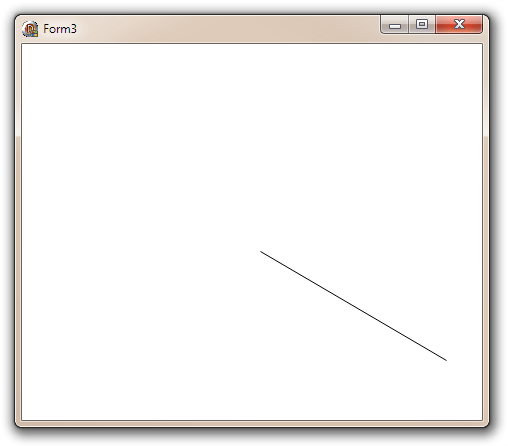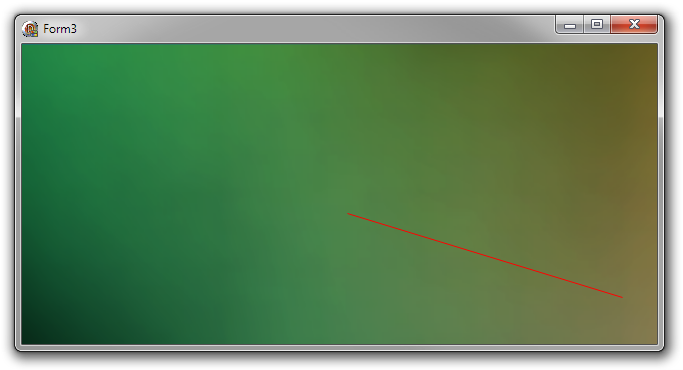Es ist nicht sehr schwer, den Anti-Aliasing-Algorithmus von Xiaolin Wu zur Darstellung von Linien in Delphi zu implementieren. Ich habe der Wikipedia-Artikel als Referenz, als ich die folgende Prozedur schrieb (eigentlich habe ich nur den Pseudocode nach Delphi übersetzt und einen Fehler korrigiert und Unterstützung für einen farbigen Hintergrund hinzugefügt):
procedure DrawAntialisedLine(Canvas: TCanvas; const AX1, AY1, AX2, AY2: real; const LineColor: TColor);
var
swapped: boolean;
procedure plot(const x, y, c: real);
var
resclr: TColor;
begin
if swapped then
resclr := Canvas.Pixels[round(y), round(x)]
else
resclr := Canvas.Pixels[round(x), round(y)];
resclr := RGB(round(GetRValue(resclr) * (1-c) + GetRValue(LineColor) * c),
round(GetGValue(resclr) * (1-c) + GetGValue(LineColor) * c),
round(GetBValue(resclr) * (1-c) + GetBValue(LineColor) * c));
if swapped then
Canvas.Pixels[round(y), round(x)] := resclr
else
Canvas.Pixels[round(x), round(y)] := resclr;
end;
function rfrac(const x: real): real; inline;
begin
rfrac := 1 - frac(x);
end;
procedure swap(var a, b: real);
var
tmp: real;
begin
tmp := a;
a := b;
b := tmp;
end;
var
x1, x2, y1, y2, dx, dy, gradient, xend, yend, xgap, xpxl1, ypxl1,
xpxl2, ypxl2, intery: real;
x: integer;
begin
x1 := AX1;
x2 := AX2;
y1 := AY1;
y2 := AY2;
dx := x2 - x1;
dy := y2 - y1;
swapped := abs(dx) < abs(dy);
if swapped then
begin
swap(x1, y1);
swap(x2, y2);
swap(dx, dy);
end;
if x2 < x1 then
begin
swap(x1, x2);
swap(y1, y2);
end;
gradient := dy / dx;
xend := round(x1);
yend := y1 + gradient * (xend - x1);
xgap := rfrac(x1 + 0.5);
xpxl1 := xend;
ypxl1 := floor(yend);
plot(xpxl1, ypxl1, rfrac(yend) * xgap);
plot(xpxl1, ypxl1 + 1, frac(yend) * xgap);
intery := yend + gradient;
xend := round(x2);
yend := y2 + gradient * (xend - x2);
xgap := frac(x2 + 0.5);
xpxl2 := xend;
ypxl2 := floor(yend);
plot(xpxl2, ypxl2, rfrac(yend) * xgap);
plot(xpxl2, ypxl2 + 1, frac(yend) * xgap);
for x := round(xpxl1) + 1 to round(xpxl2) - 1 do
begin
plot(x, floor(intery), rfrac(intery));
plot(x, floor(intery) + 1, frac(intery));
intery := intery + gradient;
end;
end;
Um diese Funktion zu verwenden, geben Sie einfach die Leinwand an, auf die gezeichnet werden soll (ähnlich wie bei den Windows-GDI-Funktionen, die einen Gerätekontext (DC) erfordern), und geben Sie die Anfangs- und Endpunkte der Linie an. Beachten Sie, dass der obige Code eine schwarz Linie, und dass der Hintergrund muss weiß sein . Es ist nicht schwer, dies auf jede Situation zu verallgemeinern, auch nicht auf alpha-transparente Zeichnungen. Passen Sie einfach die plot Funktion, bei der c \in [0, 1] ist die Opazität des Pixels bei (x, y) .
Beispiel für die Verwendung:
Erstellen Sie ein neues VCL-Projekt und fügen Sie
procedure TForm1.FormCreate(Sender: TObject);
begin
Canvas.Brush.Style := bsSolid;
Canvas.Brush.Color := clWhite;
end;
procedure TForm1.FormMouseMove(Sender: TObject; Shift: TShiftState; X,
Y: Integer);
begin
Canvas.FillRect(ClientRect);
DrawAntialisedLine(Canvas, Width div 2, Height div 2, X, Y, clBlack);
end;
![Click to magnify]()
(Vergrößern)
OpenGL
Wenn Sie ein leistungsstarkes und qualitativ hochwertiges Rendering in 2D oder 3D benötigen und alle Zeichnungen selbst vornehmen, ist OpenGL im Allgemeinen die beste Wahl. Es ist sehr einfach, eine OpenGL-Anwendung in Delphi zu schreiben. Siehe http://privat.rejbrand.se/smooth.exe für ein Beispiel, das ich in nur zehn Minuten erstellt habe. Verwenden Sie die rechte Maustaste, um zwischen gefüllten Polygonen und Umrissen umzuschalten, und klicken und halten Sie die linke Maustaste zum Schießen!
Update
Ich habe den Code nur auf einen farbigen Hintergrund (z. B. ein Foto) angewendet.
![Click to magnify]()
(Vergrößern)
Update - Die ultraschnelle Methode
Der obige Code ist ziemlich langsam, weil die Bitmap.Pixels Eigentum ist erstaunlich langsam. Wenn ich mit Grafiken arbeite, stelle ich eine Bitmap immer mit einem zweidimensionalen Array von Farbwerten dar, was viel, viel, viel schneller ist. Und wenn ich mit dem Bild fertig bin, konvertiere ich es in eine GDI-Bitmap. Ich habe auch eine Funktion, die aus einer GDI-Bitmap ein Pixmap-Array erzeugt.
Ich habe den obigen Code geändert, um auf einem Array anstelle einer GDI-Bitmap zu zeichnen, und das Ergebnis ist vielversprechend:
- Erforderliche Zeit zum Rendern von 100 Zeilen
- GDI-Bitmap: 2.86 s
- Pixel-Anordnung: 0.01 s
Wenn wir die
type
TPixmap = array of packed array of RGBQUAD;
und definieren
procedure TForm3.DrawAntialisedLineOnPixmap(var Pixmap: TPixmap; const AX1, AY1, AX2, AY2: real; const LineColor: TColor);
var
swapped: boolean;
procedure plot(const x, y, c: real);
var
resclr: TRGBQuad;
begin
if swapped then
begin
if (x < 0) or (y < 0) or (x >= ClientWidth) or (y >= ClientHeight) then
Exit;
resclr := Pixmap[round(y), round(x)]
end
else
begin
if (y < 0) or (x < 0) or (y >= ClientWidth) or (x >= ClientHeight) then
Exit;
resclr := Pixmap[round(x), round(y)];
end;
resclr.rgbRed := round(resclr.rgbRed * (1-c) + GetRValue(LineColor) * c);
resclr.rgbGreen := round(resclr.rgbGreen * (1-c) + GetGValue(LineColor) * c);
resclr.rgbBlue := round(resclr.rgbBlue * (1-c) + GetBValue(LineColor) * c);
if swapped then
Pixmap[round(y), round(x)] := resclr
else
Pixmap[round(x), round(y)] := resclr;
end;
function rfrac(const x: real): real; inline;
begin
rfrac := 1 - frac(x);
end;
procedure swap(var a, b: real);
var
tmp: real;
begin
tmp := a;
a := b;
b := tmp;
end;
var
x1, x2, y1, y2, dx, dy, gradient, xend, yend, xgap, xpxl1, ypxl1,
xpxl2, ypxl2, intery: real;
x: integer;
begin
x1 := AX1;
x2 := AX2;
y1 := AY1;
y2 := AY2;
dx := x2 - x1;
dy := y2 - y1;
swapped := abs(dx) < abs(dy);
if swapped then
begin
swap(x1, y1);
swap(x2, y2);
swap(dx, dy);
end;
if x2 < x1 then
begin
swap(x1, x2);
swap(y1, y2);
end;
gradient := dy / dx;
xend := round(x1);
yend := y1 + gradient * (xend - x1);
xgap := rfrac(x1 + 0.5);
xpxl1 := xend;
ypxl1 := floor(yend);
plot(xpxl1, ypxl1, rfrac(yend) * xgap);
plot(xpxl1, ypxl1 + 1, frac(yend) * xgap);
intery := yend + gradient;
xend := round(x2);
yend := y2 + gradient * (xend - x2);
xgap := frac(x2 + 0.5);
xpxl2 := xend;
ypxl2 := floor(yend);
plot(xpxl2, ypxl2, rfrac(yend) * xgap);
plot(xpxl2, ypxl2 + 1, frac(yend) * xgap);
for x := round(xpxl1) + 1 to round(xpxl2) - 1 do
begin
plot(x, floor(intery), rfrac(intery));
plot(x, floor(intery) + 1, frac(intery));
intery := intery + gradient;
end;
end;
und die Umrechnungsfunktionen
var
pixmap: TPixmap;
procedure TForm3.CanvasToPixmap;
var
y: Integer;
Bitmap: TBitmap;
begin
Bitmap := TBitmap.Create;
try
Bitmap.SetSize(ClientWidth, ClientHeight);
Bitmap.PixelFormat := pf32bit;
BitBlt(Bitmap.Canvas.Handle, 0, 0, ClientWidth, ClientHeight, Canvas.Handle, 0, 0, SRCCOPY);
SetLength(pixmap, ClientHeight, ClientWidth);
for y := 0 to ClientHeight - 1 do
CopyMemory(@(pixmap[y][0]), Bitmap.ScanLine[y], ClientWidth * sizeof(RGBQUAD));
finally
Bitmap.Free;
end;
end;
procedure TForm3.PixmapToCanvas;
var
y: Integer;
Bitmap: TBitmap;
begin
Bitmap := TBitmap.Create;
try
Bitmap.PixelFormat := pf32bit;
Bitmap.SetSize(ClientWidth, ClientHeight);
for y := 0 to Bitmap.Height - 1 do
CopyMemory(Bitmap.ScanLine[y], @(Pixmap[y][0]), ClientWidth * sizeof(RGBQUAD));
Canvas.Draw(0, 0, Bitmap);
finally
Bitmap.Free;
end;
end;
dann können wir schreiben
procedure TForm3.FormPaint(Sender: TObject);
begin
// Get the canvas as a bitmap, and convert this to a pixmap
CanvasToPixmap;
// Draw on this pixmap (very fast!)
for i := 0 to 99 do
DrawAntialisedLineOnPixmap(pixmap, Random(ClientWidth), Random(ClientHeight), Random(ClientWidth), Random(ClientHeight), clRed);
// Convert the pixmap to a bitmap, and draw on the canvas
PixmapToCanvas;
end;
die in weniger als einer Hundertstelsekunde 100 entzerrte Linien auf dem Formular darstellt.
Es scheint jedoch einen kleinen Fehler im Code zu geben, wahrscheinlich in der Funktion Canvas -> Pixmap. Aber im Moment bin ich viel zu müde, um zu debuggen (kam gerade von der Arbeit nach Hause).





1 Stimmen
Das Besondere an unserer SynGdiPlus-Bibliothek ist, dass Sie Ihren Zeichencode einfach mit den herkömmlichen VCL TCanvas-Methoden schreiben können. Zeichnen Sie mit einem TMetaFileCanvas und spielen Sie es dann auf einem Bitmap mit unserer Bibliothek ab. Es ist sehr schnell und funktioniert für viel mehr als nur Linienzeichnungen. Und der Platzbedarf in Ihrer Anwendungsdatei ist vernachlässigbar. Gerne können Sie Kommentare oder Fragen zu unserer Bibliothek auf unserer Website posten. Und es ist nicht nur zur Demonstration/Ausbildung gedacht: Es wird in echten Anwendungen eingesetzt, für eine großartige Darstellung, mit viel VCL TCanvas-Code (andere Programmierer dachten, es sei Dot-Net-Zeichnen :)
3 Stimmen
GDI+ erfüllt meine Anforderungen (D7).
0 Stimmen
SynGdiPlus wird mit D7 funktionieren. Besuchen Sie unser Forum: synopse.info/forum/viewtopic.php?pid=498#p498
0 Stimmen
@Bouchez - Entschuldigung, ich habe eine Verwechslung mit bilsen.com/gdiplus/index.shtml gemacht, das auch GDI Plus genannt wird.